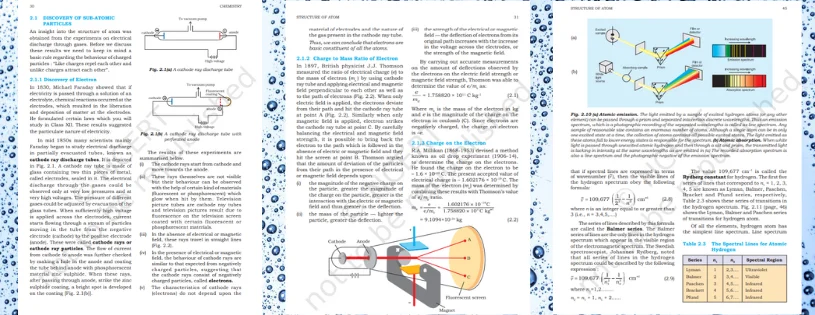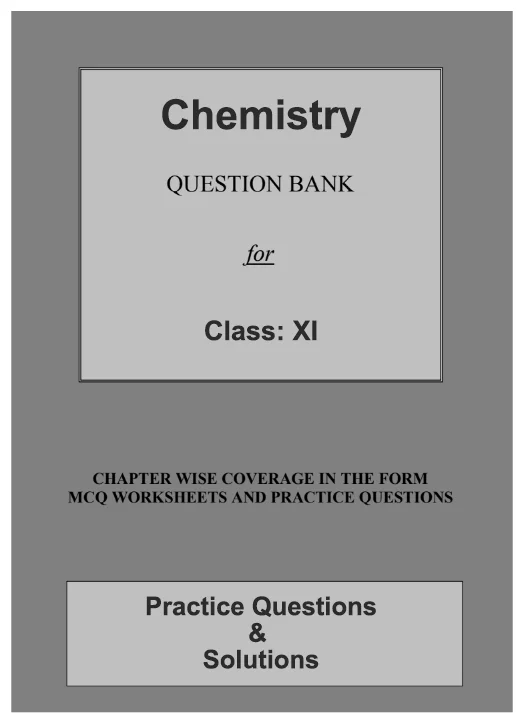At the turn of the 20th century, the prevailing model of the atom, proposed by J.J. Thomson, depicted it as a uniformly distributed "plum pudding" of positive charge with embedded negative electrons. This model, though ingenious, faced challenges that prompted further investigation into the intricacies of atomic structure. The stage was set for a new era of atomic theory with the groundbreaking experiments of Ernest Rutherford. Through his famous gold foil experiment, Rutherford uncovered unexpected results that shook the foundations of the prevailing atomic model.
Tracing the Developments Leading to Bohr's Model of the Atom in CBSE NCERT Download
What is Bohr's Model of an Atom?

Niels Bohr's model of the atom, proposed in 1913, was a significant advancement in the field of atomic physics. The Bohr Model aimed to address the limitations of previous atomic models and successfully explained the spectral lines of hydrogen. Here are the key features of Bohr's model:
-
Quantized Energy Levels: Bohr introduced the concept of quantized energy levels in an atom. According to his model, electrons orbit the nucleus in specific, quantized orbits. Each orbit corresponds to a specific energy level, and electrons can only exist in these discrete orbits.
-
Fixed Orbits: Electrons in Bohr's model move in circular orbits around the nucleus, much like planets orbiting the sun. However, unlike the continuous orbits proposed by classical physics, Bohr's model specified that electrons could only occupy certain fixed orbits with quantized angular momentum.
-
Angular Momentum Quantization: Bohr postulated that the angular momentum of an electron in a particular orbit is quantized and is an integral multiple of Planck's constant divided by 2π.
-
Energy Absorption and Emission: Electrons can move between these quantized orbits by absorbing or emitting energy. When an electron absorbs energy, it jumps to a higher energy level; when it emits energy, it returns to a lower energy level. This energy change corresponds to the emission or absorption of a photon.
-
Stability of Orbits: Bohr's model addressed the stability of orbits by proposing that electrons in certain orbits do not emit radiation. These stable orbits were referred to as "stationary" or "allowed" orbits.
-
Quantized Spectral Lines: One of the significant successes of Bohr's model was its ability to explain the spectral lines of hydrogen. The quantized energy levels of the electrons resulted in specific wavelengths of light being emitted or absorbed, leading to the observed line spectrum.
It's important to note that while Bohr's model made significant contributions and successfully explained certain phenomena, it was later superseded by more sophisticated models, particularly the quantum mechanical model.
Postulates of Bohr's model of an Atom
Niels Bohr's atomic model, proposed in 1913, introduced key postulates revolutionizing atomic theory. Electrons orbit the nucleus in fixed quantized paths, each representing a specific energy level. Energy is quantized, and electrons absorb or emit energy when transitioning between levels. Angular momentum is quantized, and stable orbits do not radiate energy. Electrons exist in discrete orbits, and each orbit has a specific radius and energy. Bohr's model successfully explained the hydrogen spectrum, marking a significant step in understanding atomic structure, although later superseded by quantum mechanics.

limitation of Bohr's Model of an Atom
Bohr's model of the atom, while groundbreaking, had limitations that later advancements in quantum mechanics addressed:
-
Limited Applicability: Bohr's model primarily worked well for hydrogen-like atoms, where only one electron is present. It struggled to predict the spectral lines of atoms with more electrons.
-
Lack of Explanation for Quantization: Bohr's model provided mathematical rules for quantized orbits but lacked a fundamental explanation for why electrons should be restricted to specific orbits.
-
Failure in Complex Atoms: For atoms with more than one electron, Bohr's model could not accurately predict the complex spectra observed, especially for elements beyond hydrogen and helium.
-
Ignoring Electron Spin: Bohr's model did not account for electron spin, a quantum property crucial for understanding the behavior of electrons in magnetic fields.
-
Violation of Heisenberg's Uncertainty Principle: Bohr's model assumed both precise position and momentum of electrons, violating the Heisenberg Uncertainty Principle, a fundamental concept in quantum mechanics.
-
Fixed Orbits and Electron Motion: Bohr's model suggests electrons move in fixed orbits, which is inconsistent with the concept of continuous electron motion described by quantum mechanics.
Despite these limitations, Bohr's model was a crucial step in the development of atomic theory, providing a bridge between classical and quantum physics and guiding further exploration of the atom's intricate nature.
CBSE Class 11th Downloadable Resources:
|
1. CBSE Class 11th Topic Wise Summary |
View Page / Download |
|
2. CBSE Class 11th NCERT Books |
View Page / Download |
|
3. CBSE Class 11th NCERT Solutions |
View Page / Download |
|
4. CBSE Class 11th Exemplar |
View Page / Download |
|
5. CBSE Class 11th Sample Papers |
View Page / Download |
|
6. CBSE Class 11th Question Bank |
View Page / Download |
|
7. CBSE Class 11th Topic Wise Revision Notes |
View Page / Download |
|
8. CBSE Class 11th Last Minutes Preparation Resources |
View Page / Download |
|
9. CBSE Class 11th Best Reference Books |
View Page / Download |
|
10. CBSE Class 11th Formula Booklet |
View Page / Download |
Being in CBSE class 11th and considering the board examinations you must be needing resources to excel in your examinations. At TestprepKart we take great pride in providing CBSE class 11th all study resources in downloadable form for you to keep you going.
Below is the list of all CBSE class 11th Downloads available on TestprepKart for both Indian and NRI students preparing for CBSE class 11th in UAE, Oman, Qatar, Kuwait & Bahrain.
SAMPLE PRACTICE QUESTIONS OF SIGNIFICANT FIGURES:
Q1. What is Bohr's model of the atom?
Answer. Bohr's model, proposed by Niels Bohr in 1913, depicts electrons orbiting the nucleus in fixed, quantized paths or shells. It introduces the concept of quantized energy levels and explains the discrete lines observed in the atomic spectra.
Q2.What is quantization in Bohr's model?
Answer. Quantization in Bohr's model refers to the specific and discrete energy levels that electrons can occupy. Electrons absorb or emit energy only when transitioning between these quantized orbits.
Q3. Why were only certain orbits stable in Bohr's model?
Answer. Bohr proposed that only orbits with certain quantized angular momentum values were stable. Electrons in these orbits did not radiate energy, providing stability.
Q4. Why did Bohr's model eventually become outdated?
Answer. Despite its success in explaining certain phenomena, Bohr's model could not address the wave-particle duality of electrons and failed to explain the behavior of complex atoms. It was superseded by more comprehensive quantum mechanical models.
Q5. What is the significance of Bohr's model in atomic theory?
Answer. Bohr's model was a crucial step in the development of atomic theory as it successfully explained the spectral lines of hydrogen and introduced the idea of quantized energy levels, setting the stage for later quantum mechanics

| CBSE CLASS 11th Chemistry Chapters |
| Chapter1: SOME BASIC CONCEPTS OF CHEMISTRY |
| Chapter2: STRUCTURE OF ATOMS |
| > Discovery of Sub-Atomic Particle |
| > Atomic Models |
| > Bohr’s Model for Hydrogen Atom |
| > Towards Quantum Mechanical Model of the Atom |
| > Quantum Mechanical Model of Atom |
| Chapter3: CLASSIFICATION OF ELEMENTS AND PERIODICITY IN PROPERTIES |
| Chapter4: CHEMICAL BONDING AND MOLECULAR STRUCTURE |
| Chapter5: THERMODYNAMICS |
| Chapter6: EQUILIBRIUM |
| Chapter7: REDOX REACTIONS |
| Chapter8: ORGANIC CHEMISTRY – SOME BASIC PRINCIPLE AND TECHNIQUES |
| Chapter9: Hydrocarbons HYDROCARBONS |
| CBSE Class 11 Physics Chapters |
| Chapter1: UNITS AND MEASUREMENTS |
| Chapter2: MOTION IN A STRAIGHT LINE |
| Chapter3: MOTION IN A PLANE |
| Chapter4: LAWS OF MOTION |
| Chapter5: WORK, ENERGY AND POWER |
| Chapter6: SYSTEM OF PARTICLES AND ROTATIONAL MOTION |
| Chapter7: GRAVITATION |
| Chapter8: MECHANICAL PROPERTIES OF SOLIDS |
| Chapter9: MECHANICAL PROPERTIES OF FLUIDS |
| Chapter10: THERMAL PROPERTIES OF MATTER |
| Chapter12: KINETIC THEORY |
| Chapter13: OSCILLATIONS |
| Chapter14: WAVES |
| CBSE Class 11 Mathematics chapter |
| Chapter1: SETS |
| Chapter2: RELATIONS AND FUNCTIONS |
| Chapter3: TRIGONOMETRIC FUNCTIONS |
| Chapter4: COMPLEX NUMBER AND QUADRATIC EQUATIONS |
| Chapter5: LINEAR INEQUALITIES |
| Chapter6: PERMUTATIONS AND COMBINATIONS |
| Chapter7: BINOMIAL THEOREM |
| Chapter8: SEQUENCES AND SERIES |
| Chapter9: STRAIGHT LINES |
| Chapter10: CONIC SECTIONS |
| Chapter11: INTRODUCTION TO THREE-DIMENSIONAL GEOMETRY |
| Chapter12: LIMITS AND DERIVATIVES |
| Chapter13: STATISTICS |
| Chapter14: PROBABILITY |
| Class 8 Link soon |
| Class 9 Link soon |
| Class 10 Link soon |
| Class 12 Link soon |
Leave a Reply